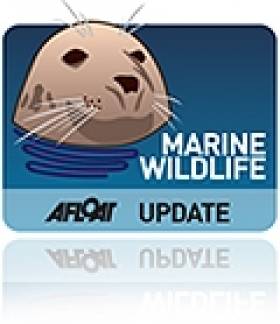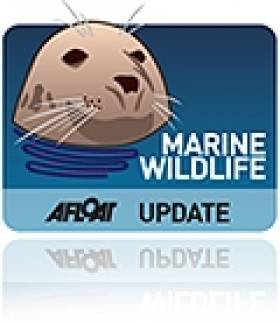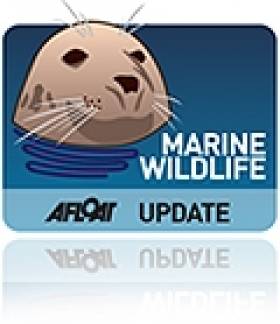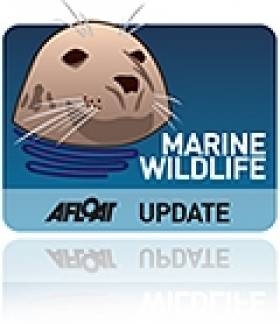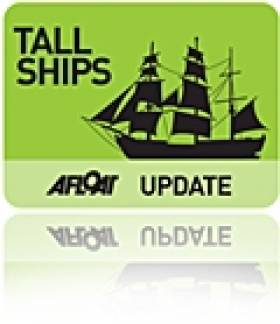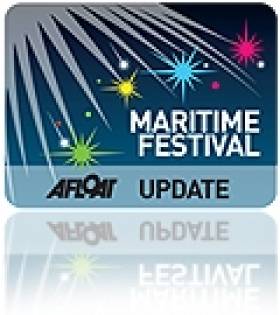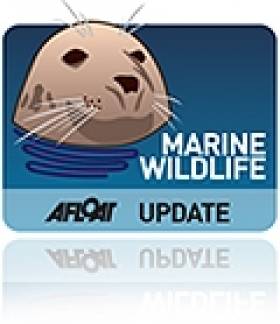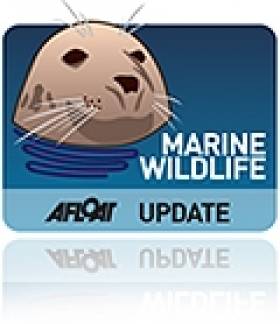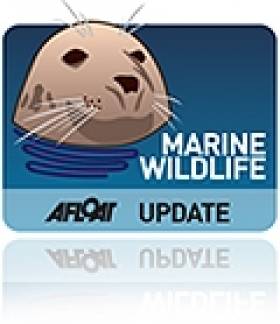Displaying items by tag: marine wildlife
Plans to Sink Baltimore Whale Carcass and Retrieve Its Skeleton
#MARINE WILDLIFE - Plans are afoot to sink the carcass of the fin whale that died after being trapped in Baltimore Harbour last week, according to the Irish Independent.
It is being proposed that the whale's body can be wrapped in netting and sunk using old train wheels as weights.
"We're looking at putting it in the water and letting it sink to the seabed where the fish and crabs can do their work and strip the flesh from the carcass," said local diver Jerry Smith. "The end scenario would be to retrieve the skeleton from the sea bed."
It's hoped that the skeleton of the 65ft female juvenile fin whale could eventually be put on display as an educational aid and a tourist attraction for the West Cork town.
Cork County Council has taken responsibility for the disposal, as the Cork Independent reports, and the 30-tonne marine giant has already been towed to Oldcourt in the Ilen esturary.
As previously reported on Afloat.ie, calls have been made to introduce a new protocol to deal with large marine wildlife strandings.
The Irish Whale and Dolphin Group (IWDG) defended itself from criticism over the handing of the "unprecedented" incident, arguing that allowing the whale to die was the best option available under the circumstances.
The Irish Independent has more on the story HERE.
Call for Whale Stranding Protocol After Baltimore Incident
#MARINE WILDLIFE - The Cork News reports that a new protocol will be introduced to deal with large marine wildlife strandings following the public backlash over the handling of the injured and malnourished fin whale in Baltimore Harbour this week.
The 30-tonne whale died on Thursday morning after being trapped in the harbour on Tuesday. As previously reported on Afloat.ie, the whale was left to die as it was found to be too ill to be assisted back into deeper water and was too large to be euthanised with drugs.
Members of the public have complained about the 'do nothing' approach taken by experts. But Dr Simon Berrow of the Irish Whale and Dolphin Group (IWDG) defended his organisation's handling of the affair, citing the lack of protocol for such an unforseen incident.
"We are recognised as the most confident group in Ireand in dealing with dolphins and whales but as a charity, it should not be our responsibility," he said. "I don't have the authority to tell someone to shoot a whale."
Dr Berrow said he had been in talks with the Defence Forces about arranging for the distressed whale to be shot before it died, most likely from wounds sustained on sharp rocks in the harbour.
Speaking with The Irish Times, the IWDG's Padraig Whooley said: "As humans, we always think we have to intervene but wildlife rarely does better when we do. In this particular case the ‘do nothing’ approach was the only option open to us."
Whooley also criticised the "fairly shocking" level of ignorance over the incident that saw crowds continue to gather at the harbour in Baltimore even after it became clear that the whale was in significant disgress.
'Nothing Can Be Done' for Stranded Whale in Baltimore Harbour
#BALTIMORE WHALE - Hopes are fading for an injured whale trapped in Baltimore Harbour, according to the Irish Independent.
It's being reported that the fin whale, which was injured on sharp rocks and beached off the pier in the West Cork harbour yesterday, is being left to die as it is too ill to be helped back to deeper water and too large to be euthanised.
It had been hoped that the whale would return to the sea under its own power by high tide but that sadly did not happen.
"Nothing can be done," Dr Simon Berrow of the Irish Whale and Dolphin Group (IWDG) told the Independent. "It can't be refloated or drigged. All you can do is let nature take its course."
The 40-foot whale became something of an instant attraction in Baltimore as crowds gathered in the harbour, as TheJournal.ie reports.
However, marine wildlife experts believe that the young whale must have been sick or malnourished to have made it so far from the open sea into the sheltered harbour.
The IWDG's Padraig Whooley also reiterated that most whale strandings end in death, and Brendan Cottrell of the Baltimore RNLI said the best thing was to do their best not to stress the animal further.
Elsewhere, a female fin whale stranded on a beach in Cornwall has died despite efforts to save her, according to the Daily Mail.
The 65-foot whale was put down by vets from British Divers Marine Life Rescue after she was found beached at Carylon Bay on the south coast on Monday morning. The whale was was described as "incredibly undernourised".
Algal Bloom Subsides off North Coast of Ireland
#algalbloom – After impacting on the marine wildlife along the north west coast for the past month, the algal bloom of Karenia mikimotoi has finally began to subside. The bloom severely affected areas of the North West from Mayo to Donegal and in certain areas down along the rest of the West coast. It impacted on coastal marine life in these areas and resulted in considerable mortalities of fish, shellfish and other coastal invertebrates. The most recent satellite imagery and seawater samples analysed by the Marine Institute show a significant decrease in the concentration compared to recent weeks.
Mr Joe Silke of the Marine Institute stated, "These blooms are part of the natural summer marine flora, and occasionally they form these exceptionally high blooms. Karenia mikimotoi is a common species in all European waters and dense bloom have been detected many times in the past. This recent bloom is similar in impact and duration to one which we experienced in 2005, and is most likely due to a combination of environmental conditions and ocean currents providing optimal conditions on the continental shelf. The accumulation of the bloom against the coastline with tidal and coastal currents causes very dense concentrations to occur. Mortalities in marine organisms particularly those living on or near the bottom are due to the algae affecting their respiratory systems and this is compounded by low oxygen in the water, particularly as the bloom is decaying."
While the bloom of this species is not known to harm humans directly, dead marine life was washed up on the shoreline, even requiring Local Authorities to temporarily close two beaches in Donegal. Discoloured reddish - brown water were observed along large expanses of the coast line. In several areas, oyster farms reported losses between 20 to 80% in some sites and farms stocking juvenile oysters also reported significant mortalities with many deciding to defer putting out new stock until the bloom passes. Other areas affected included Galway Bay, and while no mortalities were reported in this region, a shellfish hatchery in the area reported difficulty in settlement of their shellfish larvae. Local sea anglers have reported low fish catches along west and northern coasts and in some areas a complete absence of any fish. This is mainly due to fish avoiding the bloom when they can. Lobster and Prawn fishermen have also reported very poor catches in the Donegal area.
Indications from satellite and modelled data last week showed the bloom was moving back out to sea, and the latest cell counts of samples analysed in the Marine Institute today show that the bloom is has reduced significantly in the west Donegal and Sligo regions as it was last week, but it is still present Galway Bay. The Marine Institute's monitoring programme will continue to sample and monitor the bloom and post updates on our website at marine.ie and on local radio.
Wait Almost Over for Celtic Mist Relaunch
#CELTIC MIST - The wait is almost over for the relaunch of the Celtic Mist, as The Irish Times reports on the completion of its 'make-under'.
Tomorrow 12 August will see the ketch formerly sailed by late Taoiseach Charles Haughey officially begin its new life as a research vessel for the Irish Whale and Dolphin Group (IWDG), as previously reported on Afloat.ie.
Apart from extensive work to the interior of the vessel to transform crew accommodation and make space for scientific instruments, the hull of the Celtic Mist has been beautifully repainted in different shades of blue, with details such as a dolphin on its bow and a fun whale along the beam contributed by Kerry artist Michael O'Leary.
Among the new gizmos installed on the yacht - which sailed a leg of last year's Tall Ships Races - is an automatic identification system that will allow internet users to track its position online.
Conor Haughey, whose family gifted the yacht to the IWDG for its marine wildlife conservation work, is expected to attend the relaunch ceremony at Kilrush marina at 2pm, hosted by Afloat.ie's own Tom MacSweeney with a blessing by Fr Michael Sheedy of Kilrush.
Dolphin Group Celebrates Ireland's First Refloating Success
#MARINE WILDLIFE - A stranded dolphin has been successfully refloated for the first time ever in Ireland thanks to the efforts of volunteers with the Irish Whale and Dolphin Group (IWDG).
As the Irish Examiner reports, the group was alerted by a woman who saw the 3.5-metre bottlenose dolphin on a beach at Béal on the Shannon Estuary in north Kerry on 1 June.
Volunteers on the scene discovered the female dolphin's skin was still moist, which indicated it had only recently stranded.
After checking for injuries, the team decided not to wait for special whale pontoons to arrive from Kilrush and instead used a local farmer's tractor and low loader to lift the dolphin out of the sand.
The dolphin was slowly moved back to the water, where she was stabilised before she regained composure and was able to swim away.
Images of the dolphin's dorsal fin were captured by the volunteers for the IWDG's records, which enabled researchers to confirm subsequent sightings among a pod of some 140 dolphins swimming in the estuary - with the latest spotting on 27 June on a dolphin-watching boat trip, where she appeared to be in good health.
In a statement, the IWDG said: "The loss of one dolphin, especially an adult female, could have a significant impact on this population, thus highlighting the importance of the prompt action on the shore at Béal."
National Marine Week Kicks Off in Northern Ireland
#MARITIME FESTIVALS - National Marine Week has kicked off in Northern Ireland, with events taking place along the coastline till Sunday 12 August.
According to BBC News, events organised by the Ulster Wildlife Trust for the festival fortnight include a ramble on the shore of Carlingford Lough, rummaging in rock pools in Portrush, Co Antrim and Annalong, Co Down, and a coastal walk along Belfast Lough as previously reported on Afloat.ie.
There will also be a survey of the coastline's plants and wildlife considered the best indicators of climate change as part of the UK-wide Shore Thing Project.
"National Marine Week is the perfect opportunity for people to get out and explore the seaside and experience for themselves the diversity of wildlife that our seas and shores have to offer," said the Ulster Wildlife Trust's Kerri Whiteside.
"As well as being lots of fun, we hope our events will help everyone to understand the importance of protecting our vital marine habitats for the future, and inspire people to join us on our journey towards living seas, where wildlife thrives from the depths of the oceans, to the coastal shallows."
Algal Bloom Killing Fish, Shellfish Off West Coast
#MARINE WILDLIFE - An algal bloom off the west coast of Ireland is responsible for significant fish and shellfish kills from Galway to Donegal, according to the Marine Institute.
As The Irish Times reports, as much as 80% of stocks have been affected on Donegal oyster farms, and the bloom is also impacting negatively on angling tourism in the west and northwest.
The algae responsible, karenia mikimotai, occurs naturally in Ireland's coastal waters during the summer months and his harmless to humans, but contains a "toxic irritant" that damages the gills of fish, shellfish and other marine species.
Low-level samples were first detected in May but in the last two weeks it has grown into a dense bloom from Donegal to Mayo, with high levels now being recorded in Galway Bay, according to the Marine Institute's Joe Silke.
"In Donegal the bloom was so dense that there were many reports of discoloured red or brown water in some areas and several areas have reported dead marine life washing up on the shoreline, requiring local authorities to close certain beaches,” he said.
"The bloom affects species that live on or near the sea bed so we are seeing flatfish, lugworms and some shellfish getting washed up on the beaches."
The image evokes memories of the notorious 'red tide' that killed wild fish and shellfish along the west coast in 2005.
Meanwhile, the Marine Insitute said there are "some indications" that the bloom may be moving back out to sea, as observed in the latest satellite images and modelling data.
"However, cell counts of samples analysed in the Marine Institute... show that the bloom is still of the same density in the Donegal and Sligo regions as it was last week."
Carcass of Rescued 'Dolphin' Found Beached in Dundalk
#MARINE WILDLIFE - The body of a porpoise washed up on a beach near Dundalk recently is believed to be one of two 'dolphins' rescued from the area just days before.
The Dundalk Democrat reports that the porpoise carcass was discovered by Blackrock Tidy Towns supervisor Pat Rafferty while on a litter patrol of the beach on Tuesday 3 June.
“It must have beached on Monday night sometime, as we would have seen it the day before," he said. "Unfortunately it seems that gulls had got to it.”
Rafferty added: "“Maybe if it had beached during the day we would have been able to rescue it.”
It's thought that the porpoise is one of the two 'dolphins' that were rescued from the shallows by local people and the DunDalk Sub Aqua Team during the Blackrock Raft Race on 25 June.
Harbour porpoises - one of the most common forms of marine wildlife in Ireland - are very similar in apperance to dolphins but have a more triangular dorsal fin and lack the dolphin's beak-like snout.
The Dundalk Democrat has more on the story HERE.
Midsummer Night Cruise on Shannon Estuary Postponed
#MARINE WILDLIFE - Dolphinwatch Carrigaholt has postponed its midsummer night cruise on the Shannon Estuary for a second time due to poor weather.
As previously reported on Afloat.ie, the nighttime cruise to raise funds for the Irish Whale and Dolphin Group will visit caves off North Kerry, sea stacks and headlands and the mighty Loop Head, including the giant sea stack known as Dermot and Grainne’s Rock (or Cuchalain’s Leap) and Black Rock with its fantastic seabird colonies.
Along the way you will also expect to see marine wildlife such as bottlenose dolphins, and enjoy a vegetarian or seafood platter with live traditional music on board.
Organisers hope that better weather will allow them to hold the cruise next weekend on Saturday 21 July. For more information call 087 917 5984 or email [email protected].


























